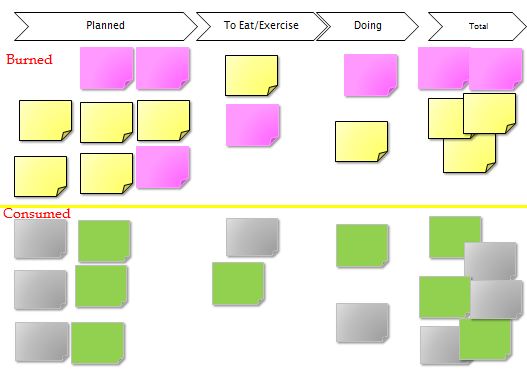In the post about #LSSC12 Turning your Conference Learning into Action, it was used as a starting point for turning a conference experience into actionable items. The post assisted you in picking one or two objectives that you would like to implement within your organization. The objectives should make an improvement that will reflect in a meaningful contribution to your organization. Set your goal with a measurement and a time. I recommend stating them by the current state to the desired future state (the goal) by a certain date. A weight loss program is the most frequent example. My current weight is 175 lbs. and my future state is 165 lbs. by July 1st (4 weeks away). This is a lag measure – an outcome.
We have a tendency to rely on lag measure. The problem with lag measures is that they are just that lagging. They give you little information to determine whether you are on the way or off track in achieving your goal. You need leading measures. More importantly, you need leading measures that you or your team has control over.
We typically start breaking down our problem into intervals:
 Does this tell us enough? Would we need a daily reminder to achieve these outcomes?
Does this tell us enough? Would we need a daily reminder to achieve these outcomes?
 Does this do anything for us except make the lag measures more current. How are we going to achieve this? What happens when we don’t lose the weight?
Does this do anything for us except make the lag measures more current. How are we going to achieve this? What happens when we don’t lose the weight?
We have only addressed the When and What with leading measures (the Why was addressed when this was tied to an existing Strategic Initiative of the organization). We must also address the How and that is where Leading Measures come into play. Leading measures are not easy to create. Many times they are only known by the people doing the work. Another way to think about this is that leading measures are at the level of individual or the team’s process, the activity that they do.
What would be a leading activity for weight loss? Calories burned and consumed are the first two that I think of. But how do we control that? Stopping short of a book on weight loss what we can see from this exercise is that we need a more compelling scorecard for us to measure ourselves against. Even when we take it down to the next level such as in a given day we need to burn 1800 calories and consume 1200 calories (believing this will give us a needed weight loss of 0.5 pounds a day) does not give us enough information to achieve our goal.
We can divide up a Kanban board with 2 swim lanes: Calories Consumed and burned. These are labeled with a description of our activities and the food we intend to eat for the day. If the Consume cards and Burn Cards are labeled with calories, you pull as needed till we total our day’s consumption or burn.
 These are the types of lead process indicators that are needed; visual, easy to understand and leading. We can recognize problems almost immediately. What happens if we do this for several days and no weight loss occurs? We may have to consume less or burn more (I know this is an over simplification). But the message is that we are working in the Now versus waiting to see results at the end of the day or week.
These are the types of lead process indicators that are needed; visual, easy to understand and leading. We can recognize problems almost immediately. What happens if we do this for several days and no weight loss occurs? We may have to consume less or burn more (I know this is an over simplification). But the message is that we are working in the Now versus waiting to see results at the end of the day or week.
Why go through this elaborate explanation? Most organizations do not leave the team or individual take the responsibility for the How. This exercise demonstrates the importance of having control of the How at the process level. Having this control at the process level, creates ownership and the ability to make the needed adjustments in the NOW zone. It is Leadership responsibility to provide strategic direction and the Why. It is the process owner’s responsibility to move that strategic direction with the How. It is also the process owner’s responsibility to report the outcomes at the desired intervals to leadership and work with leadership if the outcomes are not being achieved. This way if more resources are needed like that “exercise machine” or a coach, it can be approved and allocated. Leadership should not dictate the How but has the right and responsibility to “veto” your How if it does not agree with the overall goals of the company.
Related Information:
Developing a Learning A3
Turning your Conference Learning into Action
The Starting Point for Lean Sales and Marketing
4 Disciplines of Execution – Lean Simplified

Comments are closed.